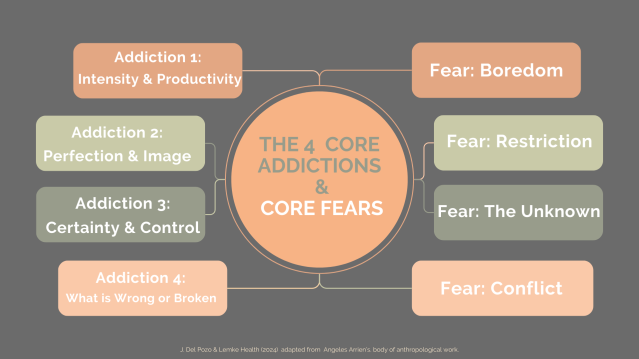Addiction
The 4 Psychic Addictions That Span the World
Identifying four core addictions across cultures, and their common features.
Updated August 9, 2024 Reviewed by Tyler Woods
Addiction, defined as compulsively seeking something despite adverse consequences, means just about anything could take on an addictive role in our lives. This includes substances, of course, but also behaviors, or process addictions, such as gambling, work, shopping, or watching television, though not all of these would be considered psychiatric conditions. Looking more closely at the core of what propels addictive behaviors—getting to the source of the pattern—can lead to long-term healing. Here, I will identify the four core addictions through a cross-cultural lens in order to increase understanding of ourselves and others. How and why do people get hooked the way they do? What is the driving force behind addiction1?
The Tibetan word shenpa captures the essence of craving, conflict, cruelty, greed, and oppression. Buddhist nun Pema Chodron writes about shenpa as the hook, or charge, behind each avoidant or attachment pattern. The pattern is often deeply engrained and serves a purpose in our life, providing some type of protection or relief, however temporary. Practicing awareness without judgment as we are becoming hooked in a moment, especially in the early stages, the charge or urge is more workable. Observing the urge behind the behavior can help to clarify more about underlying insecurity or fear.2
Angeles Arrien (1940-2014), a Basque-American cultural anthropologist and educator, identified four core addictions that arise repeatedly in all of the cultures she studied around the world. These four addictions connect us all in our shared human suffering.3

The 4 Core Addictions
1. Intensity: An addiction to intensity often presents with a constant need to be validated, productive, or busy. A person with this hook may exaggerate experiences and amplify their emotions to feel more alive. Fueled by a fear of boredom, they often bring more energy than needed to tasks, take up a lot of space in the room energetically, and may oscillate between attention-seeking behavior and withdrawing. At times unwilling to claim their own well-being, they may take on the role of a martyr or stoic. Substances may play a role of adding a sense of vitality or living life to the fullest. When discouraged, this type finds it a challenge to participate in life full-heartedly. An addiction to intensity aligns with the Healer Archetype (Archetypes will be addressed in Part 3).
2. Perfection: The hook or addiction of perfection can appear as hastiness in action and intolerance of mistakes. Someone with this addiction avoids feeling vulnerable, harboring fears of being restricted or thwarted. They may appear to deny personal needs, but invest heavily in maintaining a cultivated personal image. The archetype with this addiction is the Warrior, who often feels they have so much to do.
3. The Need to Know: Someone with an addiction to certainty has a compulsive need to know and understand things. They harbor fear of loss – loss of turf, status, items, and even worry about loss of meaning. Control plagues this type and they can come off over-controlling and righteous. In relationships it may appear as that the connection is being strategized rather than connective. Other symptoms of this addiction may be personal beliefs that are expressed in dogmatic, righteous, critical, or arrogant ways. They struggle to trust that change is a natural and inherent part of life. The illusion is that unknowns or surprises can be avoided in an uncertain future. The archetypes is the Teacher, who finds it challenging to embrace the reality of the unknowable and release judgements.
4. Fixation on What Is Broken: Someone with this addiction has a strong need for love and approval, and low tolerance for conflict. They can become fixated or hooked on what is not working, no matter how well things are going. This addiction tends to magnify negative experiences, flaws, or blow things out of proportion when they don't go their way. It is easy to forget that most of life is working and just a portion of it isn't going well. An inflexible and critical perspective makes it difficult to see personal blind spots even when someone offers another point of view. Underneath it, they may find it hard to trust their own intuition too, and therefore live in denial, unwilling to see things as they are. They may manipulate or disconnect, or strive to keep peace and harmony at all costs.
All four of the addictions above have unclaimed gifts, or human potentials, waiting to be claimed on the far side of each addiction when each resource is matured and expressed in healthy and powerful ways.
In Part 2 of this series, I will describe these unclaimed gifts and in Part 3, how each addiction also aligns with one of the four archetypes.
References
Del Pozo, J. (2024). Wisdom of the BodySoul: The Way of the Healer, Warrior, Teacher & Visionary. Monthly course in-person and on-line.
Chodron, P. (2019). Taking the Leap: Freeing Ourselves from Old Habits and Fears. Boulder, Colorado: Shambhala.
Arrien, A.(1993). The Four-Fold Way: Walking Paths of the Warrior, Teacher, Healer, and Visionary. New York: HarperCollins.


